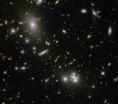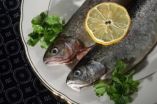(Press-News.org) Abell 68, pictured here in infrared light, is one of these galaxy clusters, and it greatly boosts the power of Hubble, extending the telescope's ability to observe distant and faint objects [1]. The fuzzy collection of blobs in the middle and upper left of the image is a swarm of galaxies, each with hundreds of billions of stars and vast amounts of dark matter.
The effect of this huge concentration of matter is to deform the fabric of spacetime, which in turn distorts the path that light takes when it travels through the cluster. For galaxies that are even further away than the cluster -- which is already at the impressive distance of two billion light-years -- and which are aligned just right, the effect is to turn galaxies that might otherwise be invisible into ones that can be observed with relative ease.
Although the resulting images projected to us of these distant galaxies are typically heavily deformed, this process, called gravitational lensing, is a hugely valuable tool in cosmology, the branch of astronomy which deals with the origins and evolution of the Universe.
These distorted images of distant galaxies are a particularly fine example of this phenomenon. In the middle of the image are a large number of galaxies stretched out into almost straight streaks of light that look like shooting stars. Meanwhile, just above and to the right of the large, bright elliptical galaxy in the upper left of the image is a spiral galaxy whose apparent shape has been stretched and mirror-morphed into the shape of an alien from the classic 1970s computer game Space Invaders! A second, less distorted image of the same galaxy appears to the left of the elliptical galaxy.
Another striking feature of the image, albeit one unrelated to gravitational lensing, is the galaxy in the top right corner of the image. What appears to be purple liquid dripping from the galaxy is a phenomenon called ram pressure stripping. The gas clouds within the galaxy are being stripped out and heated up as the galaxy passes through a region of denser intergalactic gas.
This image comes from the infrared channel of Hubble's Wide Field Camera 3, combined with near-infrared observations from the Advanced Camera for Surveys. This offers a modest taster of the kind of images that will come from the forthcoming NASA/ESA/CSA James Webb Space Telescope, which is scheduled for launch in 2018.
Infrared images are particularly useful for studying very distant objects whose light is redshifted into the infrared by the expansion of the Universe, as well as for peering through dust clouds which are opaque to visible light. The Webb telescope will produce images which are sharper than Hubble's infrared images, but more importantly, it will be much more sensitive, thanks to its advanced sensors and larger primary mirror.
The image is based in part on data spotted by Nick Rose in the Hubble's Hidden Treasures image processing competition.
INFORMATION:
Notes
[1] Hubble's ability to see distant objects will be enhanced with the start of Frontier Fields in the near future, an observing campaign that aims to combine the power of Hubble with the natural gravitational telescopes of high-magnification clusters of galaxies -- as seen here with Abell 68. This will enable Hubble to see objects that would ordinarily be too distant or faint for it to see. Frontier Fields will study six different galaxy clusters to give us a sneak preview of the very earliest stars and galaxies, before the launch of the James Webb Space Telescope in 2018.
The Hubble Space Telescope is a project of international cooperation between ESA and NASA.
Image credit: NASA & ESA. Acknowledgement: N. Rose
Links
Images of Hubble: http://www.spacetelescope.org/images/archive/category/spacecraft/
Hubble's Hidden Treasures: http://www.spacetelescope.org/projects/hiddentreasures/
Contacts
Nicola Guttridge
Hubble/ESA
Garching, Germany
Gravitational telescope creates space invader mirage
2013-03-05
ELSE PRESS RELEASES FROM THIS DATE:
Health benefits of marriage may not extend to all
2013-03-05
COLUMBUS, Ohio – Marriage may not always be as beneficial to health as experts have led us to believe, according to a new study.
Researchers made two discoveries that explain why: First, marriage provides less protection against mortality as health deteriorates, even though it does seem to benefit those who are in excellent health. Secondly, married people tend to overestimate how healthy they are, compared to others.
"We believe marriage is still good for the health of some people, but it is not equally protective for everyone," said Hui Zheng, lead author of the study ...
Heavy moms-to-be at greater risk of c-section
2013-03-05
Researchers from Norway found that women with a pre-pregnancy body mass index (BMI) of 40 had an increased risk of vacuum extraction delivery or Cesarean section (C-section). Findings that appear in Acta Obstetricia et Gynecologica Scandinavica, a journal published by Wiley on behalf of the Nordic Federation of Societies of Obstetrics and Gynecology, indicate that women with more than a 16 kg (30 lbs) weight gain during pregnancy increased their risk of forceps or vacuum extraction, and C-section.
Obesity is a global health crisis, with the World Health Organization ...
Why fish is so good for you
2013-03-05
Jena (Germany) Fish is healthy: easy to digest and with a high level of precious proteins, fish is considered an important part of a healthy diet. And with the so-called omega-3 fatty acids fish contains real 'fountains of youth'. These fatty acids – like docosahexaeonic acid (DHA) occur mostly in fatty fish like herring, salmon and mackerel. They are thought to lower the blood pressure, to strengthen the immune system and to have positive effects on the development on the nervous system and the cardiovascular system.
"Clinical studies about the intake of nutritional ...
Does the villainous 'selfish' gene undermine genome's police?
2013-03-05
PROVIDENCE, R.I. [Brown University] — For a bunch of inanimate chemical compounds, the nucleic and amino acids caught up in the infamous "selfish" segregation distorter (SD) saga have put on quite a soap opera for biologists since the phenomenon was discovered in fruit flies 50 years ago. A new study, a highlight in the March issue of the journal Genetics, provides the latest plot twist.
In TV listings the series would be described this way: "A gene exploits a rival gene's excesses, sabotaging any sperm that bear the rival's chromosome." The listing is not an exaggeration ...
Colonoscopy screening reduces risk of advanced colorectal cancer
2013-03-05
Philadelphia - A new study led by a researcher at the Perelman School of Medicine at the University of Pennsylvania adds support to current medical recommendations stating that screening colonoscopy substantially reduces an average-risk adult’s likelihood of being diagnosed with advanced colorectal cancer (CRC) in either the right or left side of the colon. In recent years, colonoscopy has begun to rapidly replace sigmoidoscopy – a procedure used to detect abnormalities in the rectum and left side of the colon – despite initially limited evidence of its efficacy and higher ...
New spectroscopy method could lead to better optical devices
2013-03-05
PROVIDENCE, R.I. [Brown University] — A multi-university research team has used a new spectroscopic method to gain a key insight into how light is emitted from layered nanomaterials and other thin films.
The technique, called energy-momentum spectroscopy, enables researchers to look at the light emerging from a thin film and determine whether it is coming from emitters oriented along the plane of the film or from emitters oriented perpendicular to the film. Knowing the orientations of emitters could help engineers make better use of thin-film materials in optical devices ...
Shadows over data sharing
2013-03-05
In a paper about to be published in EPJ Data Science, Barbara Jasny, deputy editor for commentary at Science magazine in Washington, DC, USA, looks at the history of the debates surrounding data access during and after the human genome "war". In this context, she outlines current challenges in accessing information affecting research, particularly with regard to the social sciences, personalised medicine and sustainability.
The trouble is that most researchers do not currently share their data. This is due both to research practices and research culture. Scientists withholding ...
Herbal defluoridation of drinking water
2013-03-05
Researchers in India have developed a filter system based on a medicinal herb, which they say can quickly and easily remove "fluoride" from drinking water. The technology described in the March issue of the International Journal of Environmental Engineering uses parts of the plant Tridax procumbens as a biocarbon filter for the ion.
Drinking water can contain natural fluoride or fluoride might be added as a protective agent for teeth by water companies. However, its presence is not without controversy while in some natural drinking water levels may be above those considered ...
Kirk, Spock together: Putting emotion, logic into computational words
2013-03-05
Kirk and Spock may not need a Vulcan mind meld to share cognition: Virginia Tech Carilion Research Institute scientists have found that our cold reasoning and hot feelings may be more intimately connected than previously thought.
"We tend to believe we have rational parts, like Spock, and separate emotional parts, like Kirk. But our research suggests that's not true," said Read Montague, director of the Human Neuroimaging Laboratory at the Virginia Tech Carilion Research Institute, who led the study. "We're all a combination of logical Spock and intuitive Kirk. Cold ...
When good food goes bad
2013-03-05
MARCH 5, 2013—Baltimore, MD—The Center for Biosecurity of UPMC today released online ahead of print a new report, When Good Food Goes Bad: Strengthening the US Response to Foodborne Disease Outbreaks. The authors analyzed existing data and studies on foodborne illness outbreak response, identified emerging trends, and interviewed dozens of federal and state-level officials and experts from industry, professional organizations, academia, and relevant international organizations. The report puts forth a series of recommendations to accelerate and strengthen responses to foodborne ...



